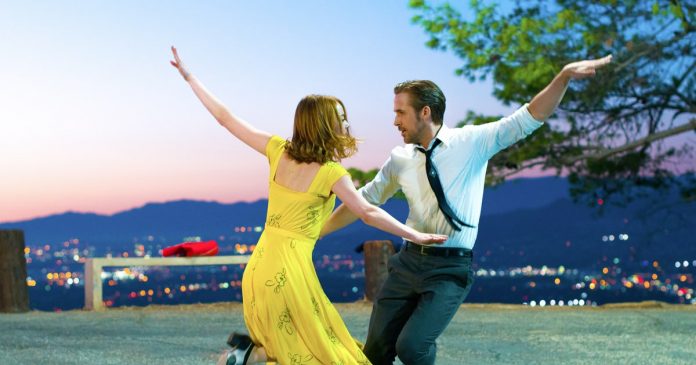After Whiplash, it became patently clear we were dealing with a special filmmaker in Damien Chazelle. Now at the age of just 31 (depressing, isn’t it?) he releases the eagerly anticipated follow-up, in the form of the ineffably enchanting, indelible romantic musical La La Land. Working as something of a love letter to classic Hollywood, and celebration of cinema in its purest form – this feature somehow manages to avoid feeling imitative, nor like a mere pastiche – which is of huge commendation to the director, who could well be sitting on the Best Picture winner with this remarkable endeavour.
Ryan Gosling plays Sebastian, a jazz fanatic and aspiring musician, playing mundane background piano at a restaurant establishment, only to be fired by his boss (J.K. Simmons) for being too creative (clearly wasn’t his tempo). Though the confrontation embarrasses Sebastian, the on-watching and wannabe actress Mia (Emma Stone) is rather impressed, only to be shrugged off when she tries to approach him. They meet again at a party soon after – and hit it off, entering in to an intense relationship, encouraging one another to fulfil their dreams, which ironically threatens to be their downfall, for balancing ambition and love in the city of stars is no easy task.
The countless references to the golden era of Hollywood are unashamed in their approach, but Chazelle is sure to ground this narrative in a world we can relate to, utilising modern technology, such as YouTube and iPhones to drive this narrative forward. But while working as an affectionate homage, there’s a barbed undercurrent that offers a more pointed take on the industry, for it’s not all glamour in this superficial environment inhabited by dreamers. Where La La Land differs from classic musicals though, is that Chazelle comes equipped with the benefit of hindsight, knowing what it is we romanticise over and playing up to it accordingly, looking back with a knowing nod and an affectionate eye. The music never feels like a mere gimmick either, and the songs, the aesthetic – they compliment the absorbing narrative, and enrich our experience.
La La Land is far from a safe bet for Chazelle either, it’s by no means a harmless romantic flick to pass the time – he remains faithful to his innovative sensibilities as a filmmaker, taking risks, and being resourceful with his means of storytelling. Every shot feels so deliberately placed too, the colour of the sunsets are vibrant and the streetlights work as spotlights for our protagonists – as each backdrop feels as though it’s been meticulously painted. What transpires is a film that just makes you feel so happy, and is enough to reignite your love for cinema as an art-form (it demands a big screen, collective viewing experience) while managing to maintain a level of profundity, with a deep sadness that exists, and lingers, throughout this tale. Stone is emblematic of this sentiment, with a nuanced turn that we’ll be hearing a lot more about in the coming months.
In spite of Sebastian’s best-efforts to preserve the spontaneity and masterful diligence of the jazz musician’s craft – one of the contributing themes is how jazz is a dying genre of music, and this notion is somewhat meta, for it can too speak about the musical, which, if you had feared was potentially going to die – it seems unlikely that will happen now. Here’s a film we’ll be talking about in 50 years time and beyond. But never mind looking forward, here’s one that revels in looking back, and while Mia, having written her first play, says to Sebastian, “it’s a bit nostalgic – will they like it”, if this wistful film is anything to go by, there’s a pretty strong chance the people will love it. Only downside is simple; good luck not whistling ‘City of Stars’ all the way home – and every day for the rest of the year.









